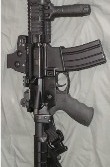How To Choose Your First Firearm - Part 3
Learn more about first firearms topics
Part 1:Firearm Buying Basics and Youth Firearms

Part 2:Personal Protection, Women & Handguns, Home Protection, Shotguns

Hunting
Check your state's hunting rules before purchasing a
firearm for hunting. Some states only allow a shotgun (with appropriate
ammunition) for hunting large game as well as fowl. Some states do not
allow semi-automatic firearms for hunting - and forget about using a
high power military firearm, like an AR 15. For the hunter, knock down
power, reliability under field conditions and accuracy over a broad
range of distances (from 40 to 200+ yards) are critical features of the
firearm.
Remember, the goal of a good hunter is one shot, one kill.
With
that in mind, the best overall rifle for the novice large game hunter
is a bolt action .30-06 ($300 to $700, including scope). The .30-06
cartridge and bullet were originally designed for military use in 1906
to deliver greater velocity and effective range. It is commonly used
today for hunting for it's reliability and accuracy. As for models,
stick with a name brands, such as Browning, Kimber, Marilin, Savage,
Springfield (click picture to enlarge), and Weatherby.
Many hunters avoid semi-automatics which can jam under field conditions
while the bolt action is reliable, accurate, simple to use and break
down for field cleaning. Lever actions, pump action and break action are
also fine, but less common in this caliber.
Learn more about rifle actions.
Others may guide you toward a Winchester .308 or other high power
hunting caliber rifles, all of which are fine, but cost more than a
modestly priced bolt actions.30-06.
Learn more about ammunition.
For small game hunting and varmint shooting, the .22 long rifle is the place to start.
To learn more about the .22 long rifle, see Part 1 of this buying guide.
|
|
|
 The best overall shotgun for the novice hunter is a 12-gauge pump action ($300 to $500). You will need to talk with your local firearms dealer and local hunters to be sure you get the right combination of barrel design, choke and ammunition for what you intend to hunt. A 12-gauge can recoil fairly hard and a few bruises are a right of passage for learning to shoot this gun. If you find the 12-gauge recoil more than you can handle, you can use a 20-gauge for some hunting applications, but you will sacrifice some effective range and knock down power. Again, talking with local shops and hunters will help you with this decision.
Learn more about shotgun gauge and ammunition.
The best overall shotgun for the novice hunter is a 12-gauge pump action ($300 to $500). You will need to talk with your local firearms dealer and local hunters to be sure you get the right combination of barrel design, choke and ammunition for what you intend to hunt. A 12-gauge can recoil fairly hard and a few bruises are a right of passage for learning to shoot this gun. If you find the 12-gauge recoil more than you can handle, you can use a 20-gauge for some hunting applications, but you will sacrifice some effective range and knock down power. Again, talking with local shops and hunters will help you with this decision.
Learn more about shotgun gauge and ammunition.
We suggest a 12-gauge pump action for it's knock down power, price and variety of configurations. You'll likely find that experienced hunters - particularly fowl hunters - prefer over under break action shotguns ($700 - $2,500) and others will prefer high end auto loaders, such as Benelli ($1,000 - $1,600). All of which are fine, but for the price and flexibility, the pump action is still a solid choice for the novice.
Learn more about shotgun actions.
Skeet and Trap Shooting
 Skeet and trap shooting are always done with shotguns. Two clay "pigeons" are released in various combinations and the goal is to break the clays with one shot each. The best shotgun for skeet and trap is a break action over under ($700 to $2,500). A side by side break ($800 - $2,200) action or pump action ($300 - $500), or autoloader / semi-automatic ($400 - $1,500) are also fine, but the over under is the gun of choice to experienced skeet and trap shooters. For the novice at this game not ready to invest that much money in a firearm, any of the other shotguns - with appropriate choke and ammunition - will do well.
Skeet and trap shooting are always done with shotguns. Two clay "pigeons" are released in various combinations and the goal is to break the clays with one shot each. The best shotgun for skeet and trap is a break action over under ($700 to $2,500). A side by side break ($800 - $2,200) action or pump action ($300 - $500), or autoloader / semi-automatic ($400 - $1,500) are also fine, but the over under is the gun of choice to experienced skeet and trap shooters. For the novice at this game not ready to invest that much money in a firearm, any of the other shotguns - with appropriate choke and ammunition - will do well.
Why is the over under shotgun preferred for skeet and trap shooting? Skeet and trap shooting requires 2 shots between reloading, quickly acquiring a moving target, and accurate point shooting on the fly. The two barrels of the over under stay in line with the shooter's line of sights (unlike the the side by side), requires no effort by the shooter to set up the second round (unlike the pump action) and can't jam between rounds (unlike the autoloader).
Target Shooting
By now, you can likely figure out that selecting a firearm for target shooting depends on what type of target shooting you want to do. If it's for personal defense, get a pistol. If it's long range target shooting, which is similar to large game hunting, go with the Springfield .30-06. If it's skeet shooting, dove hunting, home defense, etc., then go with the appropriate shotgun configuration.
If you are interested in learning overall marksmanship with going broke, then go with the .22 long rifle. Every good marksman practices with a .22 because it is way to maintain skills. In fact, the .22 is very good for practicing breath control and handling because it is so much smaller and lighter than a full size target or hunting gun and demands more concentration, particularly for free standing shots.
Assault Rifles for Target Shooting
 The AR 15 ($1,000 - $2,500), and other variations, are very popular right now, and for good reason - they are highly powerful and accurate firearms that can be easily cusotmized to your liking. However, they have limited practical use beyond the target range. Most states do not allow them to be used for hunting and because even AR's designed for hunting look like an "assault" rifle, they have other stigmas attached and are subject to added regulation.
Be sure you fully understand your states regulations on assault-style rifles before you bring home an AR, or modify it to your taste - combining adding a folding stock with a pistol grip may get you in trouble.
The AR 15 ($1,000 - $2,500), and other variations, are very popular right now, and for good reason - they are highly powerful and accurate firearms that can be easily cusotmized to your liking. However, they have limited practical use beyond the target range. Most states do not allow them to be used for hunting and because even AR's designed for hunting look like an "assault" rifle, they have other stigmas attached and are subject to added regulation.
Be sure you fully understand your states regulations on assault-style rifles before you bring home an AR, or modify it to your taste - combining adding a folding stock with a pistol grip may get you in trouble.
Based on the military AR (a reference to Arma Lite, the first manufacturer of that style of gun)
all commercially available ARs are built on identical platforms and therefore have interchangeable sections (upper, lower, stock). This is rather like all of the big automakers building all vehicles on the same frame so you can have Mercedes Benz front end, a Chevy big block engine with a ford F150 flat bed. However, not all ARs are created equal. Some companies have had problems with quality, so it is best to stick with a brand name and talk to your friends and local shop owner for recommendations.
ARs are fun to shoot and look great, no question about it, but they can be "too much" gun for the novice. We suggest learning with something easier to handle before moving up to an AR.
Learn more about first firearms topics
Part 1:Firearm Buying Basics and Youth Firearms

Part 2:Personal Protection, Women & Handguns, Home Protection, Shotguns

|





